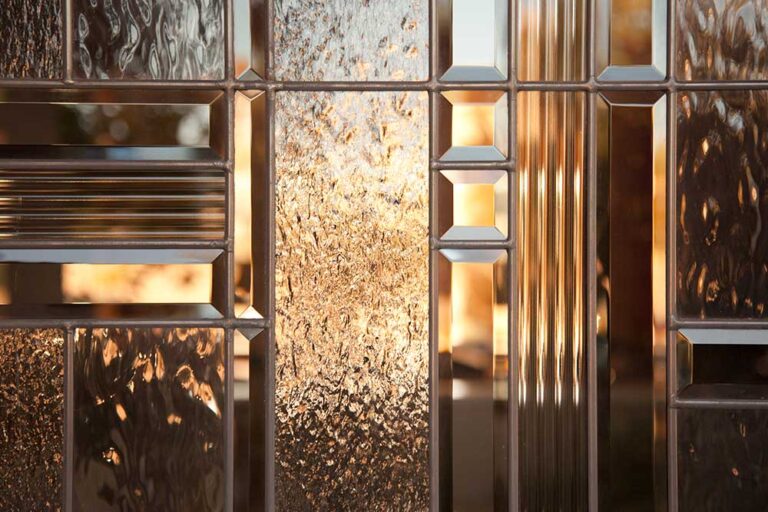1. Introduction
Beveled glass, with its elegant angles and polished edges, has adorned architectural designs for centuries. In this article, we explore the artistry, applications, and allure of beveled glass. Whether you’re an interior designer, a homeowner, or simply curious about this exquisite material, read on to discover its fascinating facets.
Beveled glass isn’t just functional—it’s an art form that transforms ordinary spaces into extraordinary ones. Let’s unravel its secrets and appreciate the beauty that lies within those beveled edges.
History of Beveled Glass:
- Beveled glass has a rich history dating back centuries. Artisans manually ground and polished the edges to create bevels, adding elegance to mirrors, windows, and furniture
- Modern techniques have streamlined the process, allowing for precise beveling in various glass thicknesses.
2. What Is Beveled Glass?
Beveled glass, characterized by its angled edges, is a single pane of glass that serves as both functional material and decorative art. Craftsmen skillfully cut and polish the edges at an angle less than 90 degrees, creating a beveled edge. While this edge doesn’t alter the glass’s functionality, it adds a touch of elegance and uniqueness.
The magic lies in how beveled glass interacts with light. When sunlight or artificial light hits the beveled surface, it refracts, creating dazzling patterns and enhancing visual depth. Whether in windows, mirrors, or furniture, beveled glass transforms ordinary spaces into extraordinary ones, making it a timeless choice for architectural and interior design
3. Beveling Techniques and Variations
Beveling is the meticulous process of creating angled surface cuts along the edges of thick glass. Traditionally, skilled artisans painstakingly ground and polished these bevels by hand, achieving exquisite results. However, modern techniques have revolutionized the process, making it more efficient and precise.
Beveled glass comes in various thicknesses, typically ranging from 1⁄4 inch (6 mm) to 1⁄2 inch (10 mm). The width of the bevel determines its visual impact—narrow bevels create subtle elegance, while wider ones offer bold sophistication. Whether framing mirrors, accentuating windows, or enhancing furniture, beveled glass remains a timeless choice that seamlessly blends craftsmanship and aesthetics.
4. Applications and Designs
- Windows and Doors:
- Entryways: Beveled glasses panels in front doors create a grand entrance. The beveled edges catch sunlight, casting mesmerizing patterns indoors.
- Sidelites: These narrow vertical windows flanking the main door often feature beveled glasses. They allow light to filter through while maintaining privacy.
- Transoms: Beveled glasses transoms above doors add height and elegance. They can be simple geometric designs or intricate patterns.
- Furniture:
- Glass Table Tops: Beveled edges on glass dining tables, coffee tables, or side tables elevate the overall aesthetic. The angled edges refract light, making the table appear weightless.
- Cabinetry and Shelves: Glass shelves with beveled edges showcase collectibles, glassware, or books with sophistication.
- Mirrors:
- Bathroom Mirrors: Beveled mirror frames create a luxurious feel in bathrooms. The angled edges add depth and dimension.
- Vanity Mirrors: Beveled vanity mirrors enhance dressing areas. They reflect light beautifully, making the space feel brighter.
- Stained Glass Art:
- Combining Beveled and Textured Glass: In stained glass windows, beveled pieces are often combined with textured or colored glass. The bevels catch light differently, creating a dynamic visual effect.
- Intricate Designs: Artisans use beveled glasses to craft intricate motifs, floral patterns, or geometric shapes. These designs adorn churches, historic buildings, and contemporary homes alike.
5. Cost Considerations
Beveled glasses, with its exquisite angles and polished edges, offers a touch of elegance to any space. However, this craftsmanship comes at a price. Let’s explore the factors that influence the cost:
- Thickness: Thicker beveled glasses tends to be costlier due to the precision required during the beveling process.
- Size: Larger pieces of beveled glasses require more material and intricate workmanship, impacting the overall cost.
- Complexity: Intricate designs, custom shapes, and multiple bevels contribute to higher costs.
Despite the premium price, investing in beveled glasses is worthwhile. Its timeless beauty and ability to transform ordinary spaces into extraordinary ones make it a valuable addition to any interior or architectural project.
For personalized glass solutions that exceed expectations, Glass World can be your trusted partner. Get in touch with us today to explore our extensive range and find the ideal glass products for your projects

